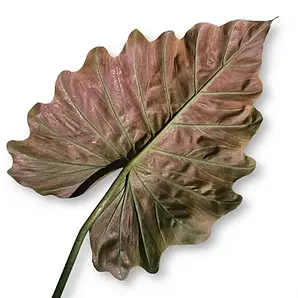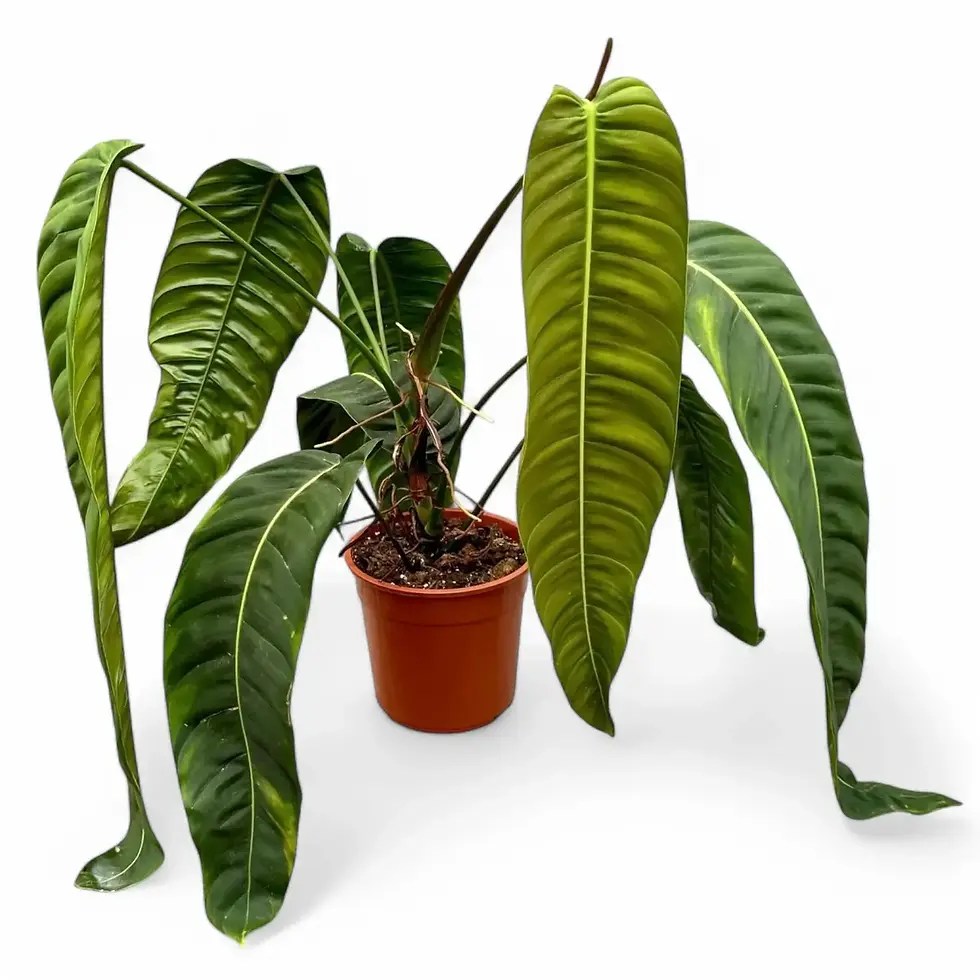
Philodendron Plants
Botanical Insights, Indoor Care & Growing Tips

Philodendron is one of the most iconic and diverse plant genera in the world of houseplants. Belonging to the Araceae family, it includes nearly 500 recognised species alongside countless horticultural hybrids and variegated cultivars. From the classic trailing Philodendron hederaceum with its heart-shaped leaves to the bold, self-heading giants once sold as Philodendron selloum, these plants have become staples of interior design, plant collections, and modern botanical culture. Their popularity is not just about looks — it comes from their adaptability. Philodendrons thrive indoors when provided with the same cues they evolved with in the tropical Americas: bright but indirect light, evenly moist yet airy soil, stable warmth, and moderate to high humidity. Native to regions stretching from Mexico and the Caribbean through Central and South America, Philodendrons occupy a variety of habitats, including lowland rainforests, river margins, and cloud forests. Many species are hemiepiphytes, beginning life in the canopy before sending roots to the ground, while others grow epiphytically or creep along the forest floor. This flexibility in nature explains why Philodendrons are so versatile indoors, whether climbing up a moss pole, trailing from a shelf, or spreading out in a shallow planter. This page is designed to be a complete resource for anyone serious about Philodendrons. It brings together botanical context, practical care guidance, and styling inspiration, while also addressing propagation techniques, common problems, and cultural significance. Whether you are a beginner searching for a hardy first houseplant or a seasoned collector looking into rare tissue-cultured species, this guide will help you grow, understand, and enjoy Philodendrons to their fullest potential.
Philodendron — What's In the Name
Pronunciation:
/ˌfɪləˈdɛndrən/ (fil-uh-DEN-drun)
Name Origin:
From the Greek phílos (φίλος, “loving”) + déndron (δένδρον, “tree”), referencing the genus’ characteristic habit of climbing trees as hemiepiphytes.
Widely Used Horticultural Names
Heartleaf Philodendron
The classic name for Philodendron hederaceum (syn. P. scandens). ⚠ Often confused with pothos (Epipremnum aureum).
Split-Leaf Philodendron
Historically applied to Philodendron bipinnatifidum and P. selloum (now reclassified as Thaumatophyllum bipinnatifidum). ⚠ Misapplied worldwide to Monstera deliciosa.
Tree Philodendron
A trade name for massive terrestrial species, especially Thaumatophyllum bipinnatifidum.
Regional Vernacular Names
Cipó-imbé / Imbé – Brazilian Portuguese terms broadly applied to climbing Philodendrons.
Guaimbé – Portuguese (Brazil), often used for Thaumatophyllum bipinnatifidum.
Hoja de corazón – Spanish (Central America), literally “heart leaf,” applied to P. hederaceum.
Misapplied Names
-
“Split-leaf Philodendron” (misapplied): Correctly refers to large-lobed Philodendrons, but widely and wrongly used for Monstera deliciosa.
-
“Philodendron pertusum” (obsolete): An outdated name historically used for Monstera deliciosa.
-
“Philodendron selloum” (outdated): A horticultural name formerly used for Thaumatophyllum bipinnatifidum.
-
“Xanadu Philodendron” (misapplied): Correct name is Thaumatophyllum xanadu, but it is still sold globally as “Philodendron Xanadu.”
💡 Key Fact: The single most persistent naming error in the plant trade is calling Monstera deliciosa a “split-leaf Philodendron.” While they are related within Araceae, Monstera and Philodendron are entirely different genera.
Philodendron Schott
The genus Philodendron was first formally described by Heinrich Wilhelm Schott in 1829, published in Wiener Zeitschrift für Kunst, Literatur, Theater und Mode 3: 780. Schott later refined the classification in his major monographs on Araceae during the mid-19th century.
Taxonomic Classification
-
Kingdom: Plantae
-
Clade: Angiosperms
-
Clade: Monocots
-
Order: Alismatales
-
Family: Araceae
-
Subfamily: Aroideae
-
Tribe: Philodendreae
-
Genus: Philodendron Schott, 1829
Diversity
-
Approximately 480–500 accepted species (POWO, Croat, IAS), though numbers fluctuate due to ongoing revisions, synonymizations, and new discoveries.
-
Represents the second-largest genus in Araceae (after Anthurium).
-
Enormous horticultural diversity: hundreds of hybrids, sports, and variegated cultivars circulate in trade (e.g., P. erubescens cultivars, P. hederaceum sports).



Philodendron: A Complete Guide to the Genus
Philodendron Care Guide – How to Grow Thriving Indoor Aroids
Philodendrons are among the most versatile houseplants you can grow, celebrated for their wide variety of growth forms — from climbing vines with heart-shaped leaves to bold, self-heading species with giant lobed foliage. Native to the tropical forests of the Americas, these plants are naturally adapted to filtered light, consistently warm temperatures, and soils that stay moist yet never stagnant. Indoors, the closer you come to recreating these conditions, the healthier and more vigorous your Philodendron will be.
Unlike many common houseplants, Philodendrons have unique traits that influence their care. Climbing philodendrons rely on aerial roots to attach themselves to bark and will reward you with larger leaves when given a moss pole or textured support. Creeping terrestrials like Philodendron gloriosum need space to crawl horizontally and demand a very airy, organic-rich substrate. Variegated cultivars require steady light to maintain their color but are not more “sun-loving” than their green counterparts.
This guide outlines the core care principles for the genus while pointing out where species and growth forms differ. For collectors or anyone curious about specific plants, our species pages provide targeted advice and habitat insights drawn from field data.
Why Native Habitat Matters
Philodendrons evolved in Neotropical rainforests, from the Mexican lowlands and Caribbean islands to the cloud forests of Colombia, Ecuador, and Brazil. Understanding this origin helps explain their preferences indoors:
-
Light: Bright, indirect light under a forest canopy, not harsh midday sun
-
Soil: Loose, humus-rich, constantly moist but well-aerated forest floor soils
-
Climate: Stable warmth and high ambient humidity year-round, with very little seasonal variation
💡 Takeaway: If you mimic rainforest cues — indirect light, chunky soil mixes, steady warmth, and humidity — your Philodendron will thrive indoors.
Light for Philodendron – Getting It Right Indoors
Light is the most important factor in Philodendron care. In their native tropical American forests, these plants grow beneath a canopy where sunlight is bright but filtered. Some species climb trees toward more abundant light, others spread as creeping terrestrials across shaded forest floors. Indoors, your placement directly determines whether leaves stay small and sparse or mature into large, vibrant foliage.
Ideal Light Conditions
Philodendrons thrive in bright, indirect light. Think of the dappled brightness under rainforest canopy: abundant but never harsh.
-
Climbing species such as Philodendron hederaceum and P. melanochrysum respond dramatically to good light. With steady indirect brightness and support to climb, leaves enlarge and mature forms (lobes, splits, or fenestrations) develop.
-
Creeping terrestrials like Philodendron gloriosum and P. plowmanii prefer consistent medium-bright light near the forest floor. They don’t chase light like climbers, but still decline in dim corners.
-
Variegated cultivars (‘Pink Princess’, ‘White Knight’, ‘Jose Buono’) need brighter indirect exposure to maintain stable variegation, though light cannot create new variegation where it doesn’t genetically exist.
Best indoor placement:
-
East-facing windows: Morning sun provides gentle, ideal light.
-
South or west windows: Place 1–2 m back or filter with sheer curtains to avoid scorch.
🔗Not sure which window in your home offers the best light?
Our guide on understanding window orientations and plant selection breaks it down.”
Light Intensity Targets
-
Maintenance growth: ~1,000–2,000 lux (100–200 foot-candles) keeps most Philodendrons healthy.
-
Strong growth and mature foliage: 2,000–5,000 lux (200–500 foot-candles) encourages larger leaves and fuller plants.
-
Upper tolerance: Above ~6,000 lux, most species risk leaf scorch indoors unless paired with high humidity and careful acclimation.
💡 Beginner tip: if your plant casts a soft but defined shadow for much of the day, you’re in the right zone.
What to Avoid
✖ Direct midday sun: Causes bleaching and crisp patches, especially on velvety-leaf species like P. melanochrysum.
✖ Dark rooms or far corners: Lead to stretched internodes, undersized leaves, and loss of mature traits such as lobes or splits.
Troubleshooting Light Stress
-
Too little light: Pale, undersized new leaves, long petioles, and weak, sprawling vines.
-
Too much light: Yellow or faded patches, dry brown margins, especially on thin or juvenile leaves.
-
Rotation tip: Turn pots every 2–3 weeks for even exposure and balanced growth.
Grow Light Guidance
Full-spectrum LED grow lights (5,000–6,500 K) are excellent substitutes in darker homes. Keep fixtures 30–45 cm above the canopy and run them 12–14 hours daily during winter or in rooms without adequate natural light. A lux meter or phone app helps fine-tune placement.
Myth Check
✖ “Philodendrons thrive in shade.” → False. While some tolerate lower light better than other aroids, deep indoor shade almost always leads to decline. Healthy Philodendrons need consistent brightness to maintain lush growth and leaf size.
🔗 If you’re battling leggy vines, our article on leggy plant growth: causes, fixes, prevention gives practical solutions
📌 Summary:
Philodendrons are rainforest plants that rely on bright, indirect light. Climbers demand it to show off mature foliage, creepers need it for steady leaf size, and variegated forms need it to hold color. Treat them as plants that love filtered brightness, not as dark-corner survivors.
❓ Still have questions about Philodendrons?
We’ve got you covered — check out our dedicated FAQ for clear answers to the most common grower questions:
Have a question about Philodendrons? Here are the answers.
Philodendron Plants on the Blog:
Check out our blog for in-depth guides on Philodendron care — from everyday tips to expert advice on keeping your plants healthy. You’ll find species-specific articles on both popular favorites and rare collector plants, plus practical guidance on watering, light, propagation, repotting, and troubleshooting common problems. Whether you’re a beginner or a seasoned grower, our blog brings together everything you need to know to help your Philodendrons thrive indoors — all in one place.

Explore Philodendron Varieties:
Popular Philodendron Varieties:
Philodendrons are highly sought-after houseplants, known for their stunning foliage and ease of care. Below are five popular varieties cherished by plant enthusiasts:
-
Philodendron gloriosum: Known for its velvety, heart-shaped leaves with striking white veins, this crawling variety is both beautiful and dramatic.
-
Philodendron verrucosum features velvety, deep green leaves with striking veins and red undersides. Its hairy stems add a unique visual appeal.
-
Philodendron melanochrysum: With deep green, velvety leaves and golden veins, this climbing Philodendron is admired for its luxurious appearance.
-
Philodendron 'El Choco Red': Its large, heart-shaped leaves with a deep red underside make it a unique addition to any collection.
-
Philodendron 'Splendid': A hybrid of Philodendron melanochrysum and Philodendron verrucosum, it boasts velvety leaves with a mix of green and red hues.
All Our Philodendron Varieties:
Browse our selection of Philodendron varieties, each featuring detailed descriptions and personalized care tips.
You can find all available Philodendron plants in our Philodendron Collection within the shop.

































































